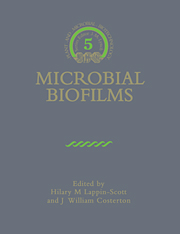Book contents
- Frontmatter
- Contents
- List of Contributors
- Series Preface
- Introduction to Microbial Biofilms
- Part I Structure, Physiology and Ecology of Biofilms
- Part II Biofilms and Inert Surfaces
- 7 Biofilm Development in Purified Water Systems
- 8 Mineralized Bacterial Biofilms in Sulphide Tailings and in Acid Mine Drainage Systems
- 9 Biofilms and Microbially Influenced Corrosion
- 10 Microbial Consortia in Industrial Wastewater Treatment
- 11 Heterogeneous Mosiac Biofilm – A Haven for Waterborne Pathogens
- Part III Biofilms on the Surfaces of Living Cells
- Index
7 - Biofilm Development in Purified Water Systems
Published online by Cambridge University Press: 24 November 2009
- Frontmatter
- Contents
- List of Contributors
- Series Preface
- Introduction to Microbial Biofilms
- Part I Structure, Physiology and Ecology of Biofilms
- Part II Biofilms and Inert Surfaces
- 7 Biofilm Development in Purified Water Systems
- 8 Mineralized Bacterial Biofilms in Sulphide Tailings and in Acid Mine Drainage Systems
- 9 Biofilms and Microbially Influenced Corrosion
- 10 Microbial Consortia in Industrial Wastewater Treatment
- 11 Heterogeneous Mosiac Biofilm – A Haven for Waterborne Pathogens
- Part III Biofilms on the Surfaces of Living Cells
- Index
Summary
Introduction
The use of purified water in various industrial and medical applications has increased dramatically over the past 20 years. These different applications often require varying levels of water quality. Each industry sets specifications for the acceptance of purified water quality based upon their product or process demands. The aggressive nature of ionically ultrapure water (18.2 Mohm cm) can contraindicate its use in, for example, stainless steel distribution systems which are often employed in the pharmaceutical industry. While the presence of trace levels of silica in condensate polishing loop waters creates great concern in the power industry, low level silica contamination of purified waters used in the production of medical devices or photomasks, for example, may not constitute cause for alarm. If any one group of contaminants can be viewed as ‘universal’ in their distribution, significance and recalcitrance, it is the bacteria and their by-products. Their role as purified water contaminants appears to cross all boundaries of purified water application and usage.
In the semiconductor industry, the demand for contaminant free water has, to a great extent, driven ultrapure water technologies. Indeed, water purification technologies have advanced to the point whereby levels of ionic, organic, and particulate contaminants can be reduced to concentrations below current analytical detection limits. Unfortunately, this industry's ability to detect and remove biological particulates and organics has not kept pace with the needs of today's sophisticated devices. Yang & Tolliver (1989) have noted that, at the 1 megabit level where minimum circuit feature size is typically 1 μm, device yields are limited by 0.1 μm jam and larger particles.
- Type
- Chapter
- Information
- Microbial Biofilms , pp. 133 - 147Publisher: Cambridge University PressPrint publication year: 1995
- 11
- Cited by



